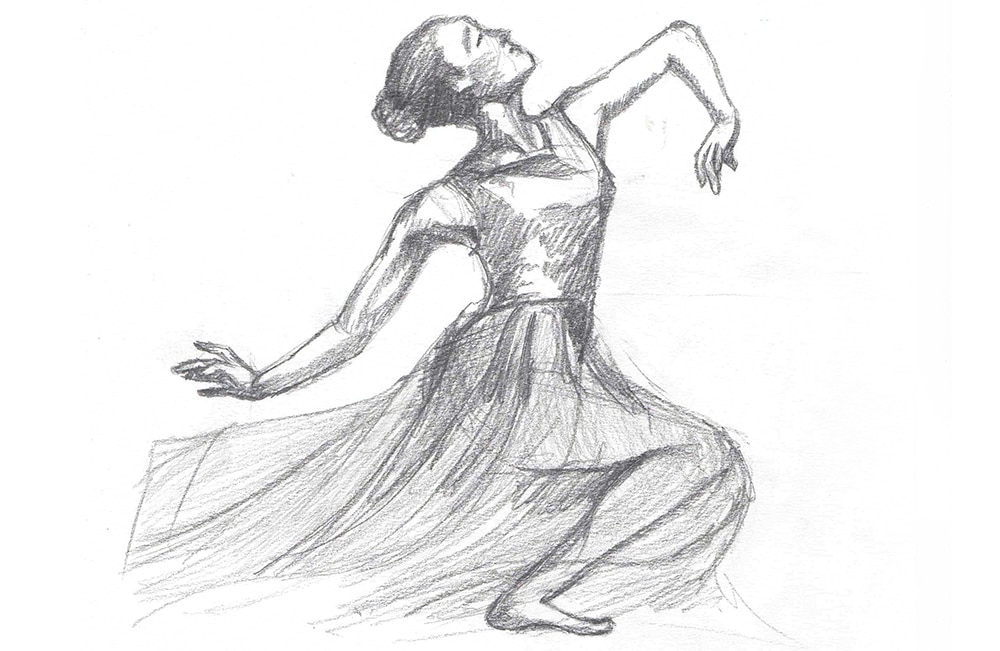Online Life Drawing Course
4502: Figure Drawing
Learn life drawing using classic techniques
Life drawing is a fundamental artistic challenge. Capturing the human figure in all its infinite, intricate variations requires both a mastery of technique and a thorough understanding of the body. In this online life drawing course, you'll make your figure drawings come to life with guidance with feedback from an expert instructor. Following traditional methods, you'll learn the standard measures and proportions artists use to achieve naturalistic and expressive figure drawings. The course builds progressively from the fundamentals to the challenges of portraiture, three-dimensional form, composition, and expression.
About This Course
Project-Based Learning
Learn and apply traditional life drawing skills with studies in proportion, gesture drawing, contour drawing, portrait styles, perspective and depth, and formal and expressive approaches.
What Skills Will I Develop?
Students in this course can expect to learn to:
- Build a foundation in life drawing skills by creating and submitting for feedback more than twenty figure drawings.
- Consider and apply in your drawing the standard measurements and proportions of the human figure.
- Identify and apply in your figure drawing the characteristic shapes and proportions of the human skeleton.
- Develop a basic ability to capture posture and motion through gesture drawing.
- See and apply in your figure drawing the characteristic shapes and proportions of human anatomy and muscle mass.
- Gain the ability to capture the shape of human subjects through contour and blind contour drawing.
- Examine and apply in your figure drawing the characteristic shapes and proportions of the human face in frontal, profile, and three-quarter views.
- Explore through your figure drawings the concepts of volume, perspective, and shading.
- Consider and apply in your figure drawing different approaches to composition, including texture, balance, rhythm, variety, unity, and emphasis.
- Demonstrate a basic ability to use expressive drawing techniques in capturing the human figure.
What Software and Supplies Do I Need?
- Computer with a minimum internet connection speed of 512 kbps. Broadband is strongly recommended.
- A digital camera or a smartphone capable of capturing high-quality images to present your artwork.
- Art and drawing supplies (full guidelines will be provided in Lesson One):
- 1 package of soft vine charcoal
- 3 charcoal pencils (HB, 2B, and 4B)
- sharpener for charcoal (a small pad of sandpaper-like quality)
- razor blades for sharpening charcoal pencils
- 4 pencils (2H, 2B, 4B, and 6B) pencil sharpener
- 1 kneaded eraser
- 2-3 pencil erasers (Magic Rub or Staedler Mars Plastic are good options)
- 1 drawing/sketch pad
- 8 1/2 " x 11" or preferably 18" x 24," tracing paper (we will use this in the lessons for anatomy and skeleton), one roll of kraft paper, one wardrobe mirror.
- Figure drawing subject(s) or yourself and a mirror.
Course Instructor(s)
The course is taught by the following instructor(s):
 Fiorella Shalat
Fiorella Shalat
Fiorella Shalat is an artist and educator with expertise in commercial still life, microscope photography, and creative darkroom techniques. Born in Florence, Italy, Fiorella has illustrated several books and her work has appeared in various group shows.
Course Outline
Measurements and Proportions
In the first week we will establish the fundamentals. You'll begin with an orientation to your art materials: charcoal, pencil, sharpeners, drawing pads, and more. You'll learn standard proportions for the male and female figure and how to measure proportions as you draw, using your eye, your pencil, a plum line, and other guides.
The Human Skeleton
The knee bone's connected to the… To draw figures well, you'll need to understand how the skeleton is put together. This session explores the main reference points inside the body that help artists represent the figure: ribcage, pelvic bone, head, shoulder blades, arms, hands, legs, feet, and vertebra. Did you know when drawing a figure, the first thing you want to do is to establish the angle of the pelvic bone? Or which differences in the skeleton differentiate men and women?
Muscles and Anatomy
It's time to put meat on your bones. Building on your knowledge of the human skeleton, you'll study the anatomy of the body and learn how to represent muscle structure in your figure drawings. Looking at anatomical drawings, artistic works, and your own body, you'll take a tour of important muscle groups, learning their defining features.
The Portrait
In this week's class, you will study the proportions of the human face. You will learn to see the important differences between male and female faces and explore techniques for drawing the forehead, the nose, the mouth, hair, eyes, teeth, and ears. Dos and don'ts will be discussed to help you avoid common mistakes in proportion and perspective.
Volume, Perspective, and Shading
Unless you're an ancient Egyptian, your life drawing will involve the representation of three-dimensional figures. This week focuses on the challenge. You'll learn how to create volume in your drawings by breaking down the figure into three-dimensional shapes. You'll discover how concepts in perspective such as the horizon line, eye level, and vanishing point affect your figure drawings, even in close up. Finally, you'll look at how the application of line, value, and shading can influence the appearance of perspective and depth in drawing.
Composition and Expression
The final lecture rounds out your figure drawing course by exploring concepts in composition and expression. You'll discover how texture, balance, rhythm, variety, unity, and emphasis can each be used in drawing—or in any art form—to give shape to a piece. Rules of composition such as the Golden Section and Divine Proportion will be discussed along with expressive considerations to help you develop your artistic approach.
Frequently Asked Questions (FAQ)
How Do The Courses Work?
Our Professional Certificate courses are project-based and instructor-led. In each course you’ll complete a series of lectures and projects designed to stretch your creative skills. The courses are delivered on a flexible schedule with no set-logins or Zoom meetings. You can study when you want, provided you complete your program by the assigned deadline.
Who Are The Instructors?
Our courses are developed and taught by our industry-leading faculty of creative professionals. This means that you’ll learn in-demand skills, get feedback on your work, and build a portfolio of creative work. View our Student Gallery for featured student projects.
When Can I Start?
You can enroll in this course on an individual basis or as part of a Professional Certificate program. Professional Certificate programs start every month on the first of the month. With rolling admissions, you can start as soon as you complete Orientation.
Explore Professional Certificate Programs: Graphic Design | Web Design | Multimedia | Digital Arts | Marketing Design | Fine Arts
How Do I Register?
To register for a Professional Certificate program, complete our program application. To register for this course on an individual basis, please contact our admissions team at admissions@sessions.edu. An Admissions Advisor will contact you to setup your enrollment.
| Course Tuition and Fees | |
|---|---|
| Tuition | $949 |
| Registration Fee* | $50 |
| Total Course Price | $999 |
Registration fees are nonrefundable after 5 days from enrollment.
Is Sessions College Accredited?
Yes. Since 2001, Sessions College has been accredited by the Distance Education Accrediting Commission (DEAC). The Distance Education Accrediting Commission is listed by the U.S. Department of Education as a recognized accrediting agency and is recognized by the Council for Higher Education Accreditation (CHEA).






















